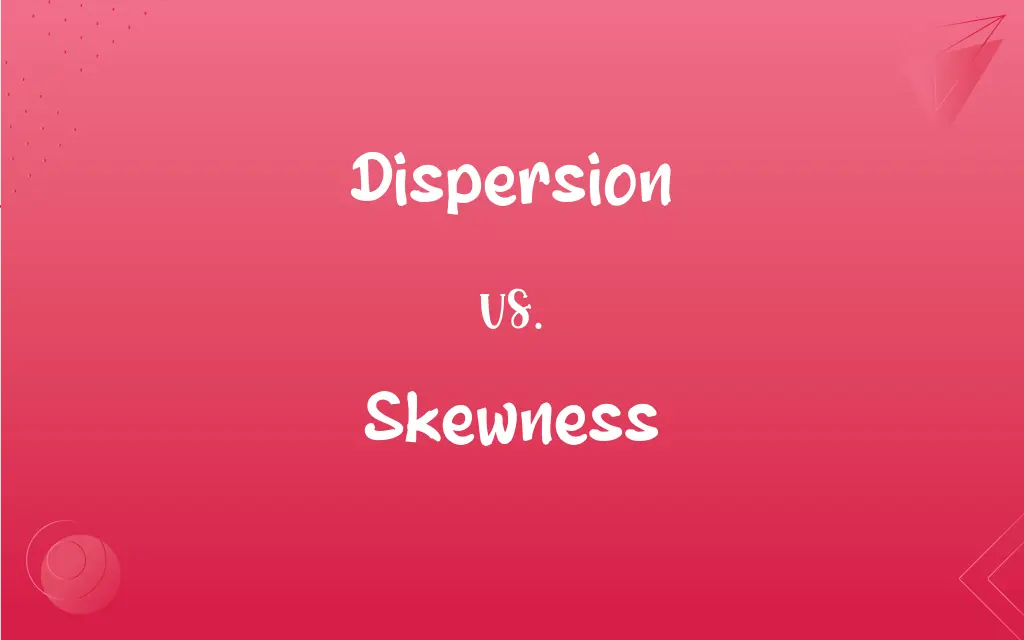Dispersion vs. Skewness: What's the Difference?
Edited by Aimie Carlson || By Janet White || Published on February 28, 2024
Dispersion measures the spread of data values around a central value, while skewness indicates the asymmetry of the data distribution.

Key Differences
Dispersion in statistics refers to how spread out a set of data is, indicating the variability around a central point like the mean or median. Skewness, on the other hand, measures the degree to which a distribution leans towards one side, either left or right, of its average.
Common measures of dispersion include range, variance, and standard deviation, which quantify the extent of variation in data. Skewness quantifies how much a distribution differs from a normal distribution in terms of asymmetry.
A high dispersion indicates a wide spread of data values, which can be symmetrical or asymmetrical. High skewness indicates a distribution that is not symmetrical, with a longer tail on one side of the peak.
Dispersion is essential in understanding the reliability of the central tendency measures, while skewness is crucial in identifying the nature of the distribution of the data.
In practical terms, dispersion helps in understanding the risk and consistency in fields like finance and quality control. Skewness is used in various domains to understand the direction of bias in data.
ADVERTISEMENT
Comparison Chart
Definition
Measures spread of data around a central value
Measures asymmetry of data distribution
Key Metrics
Range, variance, standard deviation
Degree of asymmetry from normal distribution
Implication
Indicates variability or consistency
Indicates direction of bias
Symmetry
Can be symmetrical or asymmetrical
Specifically indicates lack of symmetry
Use Cases
Risk assessment, quality control
Identifying biases, data analysis
ADVERTISEMENT
Dispersion and Skewness Definitions
Dispersion
A measure of the spread of data values.
The dispersion in test scores indicates varying student performance levels.
Skewness
Useful in identifying biases in data sets.
The skewness in survey responses revealed a bias among participants.
Dispersion
Indicates variability around a central point.
The wide dispersion of housing prices in the city reflects economic diversity.
Skewness
Can be positive or negative, indicating direction of tail.
Negative skewness means the tail is longer on the left side.
Dispersion
Important in understanding risk and consistency.
Financial analysts use dispersion to assess investment risks.
Skewness
A measure of the asymmetry of a data distribution.
The positive skewness indicates a long tail to the right of the mean.
Dispersion
Quantified by range, variance, or standard deviation.
The large standard deviation shows high dispersion in the data.
Skewness
Indicates how much a distribution differs from normal.
The high skewness of the data suggests a non-normal distribution.
Dispersion
Useful in assessing the reliability of averages.
Given the low dispersion, the mean is a reliable measure in this case.
Skewness
Important in statistical analysis and modeling.
Adjusting for skewness is crucial in developing accurate models.
Dispersion
The act or process of dispersing.
Skewness
To turn or place at an angle
Skew the cutting edge of a plane.
Dispersion
The state of being dispersed.
FAQs
What is dispersion in statistics?
Dispersion measures the spread of data around a central point.
What does a high dispersion indicate?
High dispersion indicates a wide range of values around the central point.
Can skewness be both positive and negative?
Yes, skewness can be positive (right tail longer) or negative (left tail longer).
What are examples of dispersion measures?
Range, variance, and standard deviation are common measures of dispersion.
What does standard deviation tell you about data?
Standard deviation indicates the average distance of data points from the mean.
Can skewness be used to identify outliers?
Skewness can help in identifying the presence of outliers, especially in asymmetrical distributions.
Why is skewness important in data analysis?
Skewness helps understand the direction and extent of bias in data distribution.
How does positive skewness affect data interpretation?
Positive skewness implies a longer right tail, often impacting the mean.
How does negative skewness look in a graph?
In a graph, negative skewness shows a longer tail to the left of the distribution's peak.
Are all normal distributions skewness-free?
Yes, normal distributions have a skewness of zero, indicating symmetry.
How is skewness different from dispersion?
Skewness measures the asymmetry of a data distribution, unlike dispersion, which measures spread.
Is dispersion a measure of data quality?
Dispersion can be indicative of data quality, especially in terms of consistency.
Is a high range always indicative of high dispersion?
Generally, yes, a high range indicates wider dispersion, but context is important.
Can skewness be zero?
Yes, a skewness of zero indicates a symmetrical distribution.
What role does dispersion play in risk assessment?
In risk assessment, dispersion helps in understanding the variability and potential unpredictability of outcomes.
Does high dispersion mean high variability?
Yes, high dispersion signifies greater variability in data values.
Can dispersion be negative?
No, dispersion measures are always non-negative as they represent a spread or distance.
Is it possible to have zero dispersion?
Zero dispersion occurs when all data points are identical, showing no variability.
How is variance related to dispersion?
Variance is a measure of dispersion, quantifying how far data points are spread from the mean.
What does it mean if a data set is skewed to the right?
It means the right tail of the distribution is longer, often with a cluster of lower values.
About Author
Written by
Janet WhiteJanet White has been an esteemed writer and blogger for Difference Wiki. Holding a Master's degree in Science and Medical Journalism from the prestigious Boston University, she has consistently demonstrated her expertise and passion for her field. When she's not immersed in her work, Janet relishes her time exercising, delving into a good book, and cherishing moments with friends and family.
Edited by
Aimie CarlsonAimie Carlson, holding a master's degree in English literature, is a fervent English language enthusiast. She lends her writing talents to Difference Wiki, a prominent website that specializes in comparisons, offering readers insightful analyses that both captivate and inform.































































